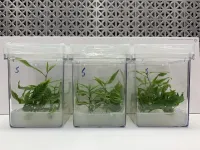Cellphone converts into powerful chemical detector
With only $50 worth of components, an ordinary cellphone transforms into a sophisticated scientific instrument, capable of identifying chemicals, drugs, and pathogens
2021-05-04
(Press-News.org) WASHINGTON, May 4, 2021 -- Scientists from Texas A&M have developed an extension to an ordinary cellphone that turns it into an instrument capable of detecting chemicals, drugs, biological molecules, and pathogens. The advance is reported in Reviews of Scientific Instruments, by AIP Publishing.
Modern cellphones include high-quality cameras capable of detecting low levels of light and eliminating digital noise through software processing of the captured images. Recent work has taken advantage of this sensitivity to produce cellphone cameras that can be used as portable microscopes and heart rate detectors.
The current advance is based on two types of spectroscopy. One type, known as fluorescence spectroscopy, measures the fluorescent light emitted by a sample. Another, known as Raman spectroscopy, is useful for detecting molecules, such as DNA and RNA, that do not fluoresce or emit light at very low intensities. Both types were used to develop this cellphone detector.
The system includes an inexpensive diode laser as a light source, oriented at right angles to the line connecting the sample and the cellphone camera. The right-angle arrangement prevents back reflected light from entering the camera.
"In addition, this right-angle excitation geometry has the advantage of being easier to use for the analysis of samples where a bulk property is to be measured," said author Peter Rentzepis.
The investigators studied a variety of samples using their constructed cellphone detector, including common solvents such as ethanol, acetone, isopropyl alcohol, and methanol. They recorded the Raman spectra of solid objects, including a carrot and a pellet of bacteria.
Carrots were chosen for this study because they contain the pigment carotene. The laser light used in their system has a wavelength that is easily absorbed by this orange pigment and by pigments in the bacteria.
The investigators compared the sensitivity of their system to the most sensitive industrial Raman spectrometers available. The ratio of signal to noise for the commercial instrument was about 10 times higher than the cellphone system.
The sensitivity of the cellphone detector could, however, be doubled by using a single RGB channel for analysis. The system has a rather limited dynamic range, but the investigators note that this problem can be easily overcome through several HDR, or High Dynamic Range, applications that combine images from multiple exposures.
The additional components, including the laser, add a cost of only about $50 to the price of a typical cellphone, making this system an inexpensive but accurate tool for detecting chemicals and pathogens in the field.
INFORMATION:
The article "Cell-phone camera Raman spectrometer" is authored by Dinesh Dhankhar, Anushka Nagpal, and Peter M. Rentzepis. The article will appear in Review of Scientific Instruments on May 4, 2021 (DOI: 10.1063/5.0046281). After that date, it can be accessed at https://aip.scitation.org/doi/10.1063/5.0046281.
ABOUT THE JOURNAL
Review of Scientific Instruments publishes novel advancements in scientific instrumentation, apparatuses, techniques of experimental measurement, and related mathematical analysis. Its content includes publication on instruments covering all areas of science including physics, chemistry, materials science, and biology. See https://aip.scitation.org/journal/rsi.
[Attachments] See images for this press release:

ELSE PRESS RELEASES FROM THIS DATE:
2021-05-04
SAN ANTONIO (May 4, 2021) - Risk-reducing mastectomy saves lives of women who, because of hereditary or other risk factors, may have a very high lifetime risk of developing breast cancer, according to two new journal articles written to guide physicians and patients. All of these women should also discuss with their physicians nonsurgical options such as screening and medications to reach the best, customized treatment strategy, the essays mention.
Both articles, published May 4 in the Journal of the American Medical Association (JAMA), are by END ...
2021-05-04
WHO Benjamin Rome, MD, Instructor of Medicine at Harvard Medical School and researcher in the Program On Regulation, Therapeutics, And Law (PORTAL) in the Division of Pharmacoepidemiology and Pharmacoeconomics, Brigham and Women's Hospital; corresponding author of a paper published in JAMA Network Open.
WHAT When drug manufacturers raise the list price for brand-name prescription drugs, do patients' out-of-pocket costs rise too? A new study published in JAMA Network Open by Dr. Benjamin Rome and colleagues in the Brigham's Division of Pharmacoepidemiology and Pharmacoeconomics finds that more than half of patients may experience increases in out-of-pocket spending when drug ...
2021-05-04
BOSTON - Researchers from Massachusetts General Hospital (MGH) appear to have solved the 120-year-old mystery surrounding the failing health of famed Antarctic explorer Sir Ernest Shackleton over the course of his daring expeditions to Antarctica in the early part of the twentieth century. In a paper published online in the END ...
2021-05-04
Researchers have found that people who live beyond 105 years tend to have a unique genetic background that makes their bodies more efficient at repairing DNA, according to a study published today in eLife.
This is the first time that people with 'extreme longevity' have had their genomes decoded in such detail, providing clues as to why they live so long and manage to avoid age-related diseases.
"Aging is a common risk factor for several chronic diseases and conditions," explains Paolo Garagnani, Associate Professor at the Department of Experimental, Diagnostic ...
2021-05-04
Studying protein changes in the kidneys as we age, as well as the transcription of genes into proteins, helps provide a full picture of the age-related processes that take place in these organs, says a study in mice published today in eLife.
Aging causes many changes in the body and in essential organs such as the kidneys, which function less efficiently later in life. Age-related changes in the kidneys have mostly been reported by looking at the transcription of genes - the process by which a segment of DNA is copied into RNA. The current study suggests that this approach, combined with studying changes in proteins, gives us a better understanding of age-related changes in the kidney and may point to new approaches for treating ...
2021-05-04
TAMPA, Fla. (May 4, 2021) -- Repetitive transcranial magnetic stimulation, or rTMS, was FDA approved in 2008 as a safe and effective noninvasive treatment for severe depression resistant to antidepressant medications. A small coil positioned near the scalp generates repetitive, pulsed magnetic waves that pass through the skull and stimulate brain cells to relieve symptoms of depression. The procedure has few side effects and is typically prescribed as an alternative or supplemental therapy when multiple antidepressant medications and/or psychotherapy do not work.
Despite increased use ...
2021-05-04
LONDON, ON - New findings from Ontario have shown that children born in Sarnia have a higher risk of developing asthma compared to neighbouring cities. A research team from Lawson Health Research Institute and Western University, using provincial data from ICES, found that higher air pollution exposure in the first year of life very likely contributed to this higher risk. Their results are published today in CMAJ Open.
Summary of study results:
-Children born in Sarnia in the 1990s and early 2000s were disproportionally at a higher risk of developing asthma in the first few years of life, compared to neighbouring cities.
-Air pollution exposure ...
2021-05-04
Agência FAPESP – White-sand savannas are expanding in the heart of the Amazon as a result of recurring forest fires, according to a study published in the journal Ecosystems.
The study was supported by FAPESP, and conducted by Bernardo Monteiro Flores, currently a postdoctoral fellow in ecology at the Federal University of Santa Catarina (UFSC) in Brazil, and Milena Holmgren, a professor in the Department of Environmental Sciences at Wageningen University in the Netherlands.
“The edges of the Amazon Rainforest have long been considered the ...
2021-05-04
FINDINGS
A new study by researchers at the UCLA Jonsson Comprehensive Cancer Center has identified a novel combination therapy to potentially help overcome resistance to immunotherapy in people diagnosed with advanced lung cancer. The combination approach uses immune checkpoint inhibitors with ATRA, a safe medication that is widely used to treat leukemia. The team found the combination therapy led to eradication of over 70% of tumors when tested in mice with LKB1-deficient lung cancer. It also generated durable tumor-specific immunity.
BACKGROUND
Immune checkpoint inhibitors have substantially ...
2021-05-04
As nurseries and garden centers fill up with spring landscaping plants, home gardeners owe a lot to a technique called micropropagation, which has proven beneficial to many plants - perhaps soon to include cannabis, thanks to work by UConn researchers in the College of Agriculture, Health, and Natural Resources.
Micropropagation is a technique used for growing large quantities of new plants from fewer "parent" plants, yielding clones with the same, predictable qualities. The cannabis (Cannabis sativa) industry, however, has been largely left out of this beneficial technique, because this species of plant is extremely difficult to micropropagate.
Researchers from UConn - including Associate Professor Jessica Lubell-Brand, Ph.D. student Lauren Kurtz, and Professor Mark ...
LAST 30 PRESS RELEASES:
[Press-News.org] Cellphone converts into powerful chemical detector
With only $50 worth of components, an ordinary cellphone transforms into a sophisticated scientific instrument, capable of identifying chemicals, drugs, and pathogens



